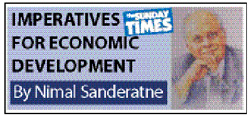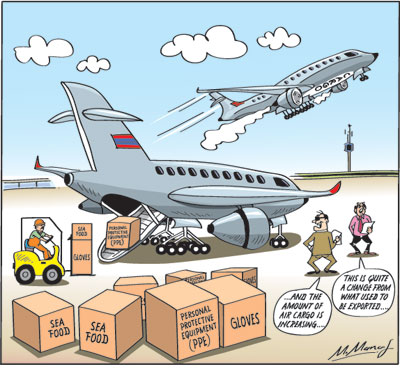Columns
Reviving the economy in a changing global economic environment
View(s):Can the Sri Lankan economy that is dependent on exports, workers’ remittances and earnings from tourism revive in the current inhospitable global economic conditions?
A credible answer as to what extent the economy could revive cannot be given as the performance of the Sri Lankan economy is very much dependent on several global uncertainties. How and when the pandemic would be contained and there would be a global economic recovery remains uncertain.
 Responding to challenges
Responding to challenges
Meanwhile, the revival of the economy would depend on the capacity of the economy to respond to the changing global economic challenges and opportunities. Fortunately, there are signs of an export revival with industries responding to the changing patterns of international demand.
Global uncertainties
The length of time for the containment of the pandemic and for the recessionary conditions to be reversed and the nature of the new international economy that would emerge remain uncertain. There is much conjecture and speculation on the speed and character of the economic recovery.
Global economic recovery
Economists differ widely on the speed and nature of the global economic recovery. While some expect it to be U-shaped with a gradual revival, others predict it to be V-shaped with the global economic recovery rising fast after hitting a bottom. Still others expect it to be W-shaped with it rising fast after declining to fall and rise again. Still others expect it to flatten after a recovery in the form of a V.
Speculations
These are all speculations. In any event a significant global economic recovery could be expected only after the pandemic is brought under control. Furthermore, the impact of monetary and fiscal policies to mitigate the economic and social repercussions of the lockdown could also postpone the economic recovery.
Revival
The revival of the global economy cannot be expected until there is a significant containment of the COVID-19 pandemic that is spreading in many parts of the world, including the developed western countries that are the main markets for our manufactured exports as well as are the countries of origin of many tourists to the country.
 Recovery from pandemic
Recovery from pandemic
There is no certainty as to when the world would recover from the pandemic. The World Health Organisation (WHO) does not expect the pandemic to be eliminated or reduced to insignificant proportions for at least two years. With the virus still spreading in most parts of the world, except East Asia, there is no certainty of containing its spread globally.
On the other hand, there is a resurgence of the virus in countries that contained it and a possibility of a second and even a third wave of the COVID-19 virus.
Implications
The economic implication of this for us is that international trade would be hampered and many internationally demanded products like apparel, ceramics, solid tyres and similar items that we export, would be severely reduced.
Conversely, there would be increased demand for other goods like personal protective equipment, sea food and detergents. There would also be a shift in demand from the countries affected by the pandemic to those that have recovered from it.
Response
In such a changing international economy, the capacity of the Sri Lankan economy to respond to changes in global demand would determine the resilience of the economy in the intervening period of global economic downturn. The ability of exporters to exploit the increased demand for new products and cater to the emerging new markets would determine the country’s export earnings.
Responding to challenges
There has been an encouraging response of private sector export industries to the adverse global conditions. They have adapted to the changing international demand for goods. Apparel, ceramics, rubber tyres and similar products have dried up. However, manufactured exports have not decreased by much recently owing to industrialists adapting to produce new products.
There has been an increase of manufactured exports owing to these industries shifting from heavy duty tyres to surgical and other gloves and from garments to personal protective equipment (PPE).
Exports in June to August
In June, July and August exports of manufactured goods increased from those of the first half of the year. Exports averaged a little less than US$ one billion (US$ 960 million) in these three months. In June it was US$ 906 million, in July it was US$ 1.09 billion and in August it was US$ 969 million. This was achieved owing to a shift in production in response to changing international demand.
Sea food
Exporters have also responded to the shift in consumption from meat to sea food and increased sea food exports. This reorientation in exports and expansion of new markets would be important for the continued revival of the economy. Markets in East Asia are new export prospects that must be explored.
Two setbacks
In contrast to merchandise exports, earnings from tourism and remittances from abroad cannot be expected to revive next year. Their revival is uncertain.
The huge decrease in earnings from tourism and workers’ remittances that together contributed US$ 11.4 billion to the balance of payments in 2018, are severe setbacks to the economy. They would increase the country’s external financial vulnerability.
Tourism
Tourist traffic will be severely curtailed owing to the lesser desire of foreigners to travel due to fears of the virus, higher costs of air travel, health regulations for travellers, lower incomes and other disincentives for travel.
Therefore it would indeed be quite some time when we could reach the tourist earnings of US$ four billion in 2018. Domestic tourism would have to support the hospitality trade for quite some time. However this would not be of help for the country’s foreign earnings.
We could expect an initial increase in tourists from the East, especially China. However a cautious approach that ensures that COVID-19 is not reintroduced into the country is mandatory.
Protecting the country from infection from abroad is a prerequisite to allowing tourists into the country. It wold be a serious flaw to allow tourists to come prematurely before the global epidemic is eliminated. The country would face even more serious economic consequences than during this year if there is a second wave of the epidemic.
Remittances
Decreasing remittances from abroad will continue till global conditions change significantly. Workers’ remittances may not exceed US$ three to fourbillion this year.
Summary and Conclusion
The Sri Lankan economy will be adversely affected as long as the global recession lasts. And a global economic recovery cannot be expected until the corona pandemic is contained significantly. Unfortunately there are no signs of such reduction, especially in the West and in India, that matter for our economy.
The prediction is that the pandemic would take as long as about three years to be eliminated. COVID-19 has however been minimised in China, Vietnam and South Korea whose economies are reviving.
The economic implications of this for the country are threefold. We cannot expect to sell the same merchandise as before to western countries and have to reorient our merchandise exports to meet new requirements. Second, new export markets in the East offers a new prospect of increased export earnings. Third, earnings from tourism and remittances from abroad cannot be expected to be substantial for the next few years.


Leave a Reply
Post Comment